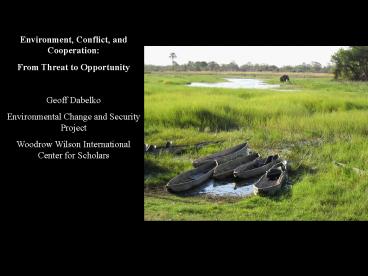Environment, Conflict, and Cooperation: - PowerPoint PPT Presentation
1 / 31
Title:
Environment, Conflict, and Cooperation:
Description:
Facilitating dialogue between research and policy communities ... Fungible, portable, and lucrative. Worth fighting over. DRC. Liberia. Funding the fighting ... – PowerPoint PPT presentation
Number of Views:76
Avg rating:3.0/5.0
Title: Environment, Conflict, and Cooperation:
1
Environment, Conflict, and Cooperation From
Threat to Opportunity Geoff Dabelko Environmenta
l Change and Security Project Woodrow Wilson
International Center for Scholars
2
Woodrow Wilson International Center for Scholars
- Environmental Change and Security Project
- Nonpartisan, non-advocacy
- Facilitating dialogue between research and policy
communities - Lee H. Hamilton Wilson Center President
3
Presentation Outline
- Environment and Conflict A Range of Links
- Scarcity and Conflict
- Abundance and Conflict
- Environmental Pathways to Peace
- Key Challenges and Questions
4
Environment and Conflict A Range of Links
- Environmental damage from warfare
- Environment as tool of war
- Forests as base for combatants
- Combat zone as conservation zone
5
Natural Resources and Conflict The Scarcity
Thesis
- Environmental degradation/depletion and violent
conflict - Almost exclusive focus on developing countries
- Focus on renewable resources and VIOLENT conflict
- Lots of small c conflict not well-integrated
into analysis
6
Environmental Scarcity and Conflictfrom Thomas
F. Homer-Dixon (1999)
7
The Environment and Conflict Thesis Case Study
Conclusions
- The environment is neither a necessary nor
sufficient cause of violent conflict - Underlying, subnational, and diffuse
environmental contributions to violent conflict - Indirect role in intrastate, rather than
interstate, violent conflict - Fisheries, arable land, water, and deforestation
are the most salient renewable resources
8
Environment and Conflict Conclusions (cont.)
- Environmental scarcity contributes to
- Migration (marginal lands, urban areas)
- Undercutting economic activity
- Resource capture by elites
- Weakening of states
- If adaptation is not sufficient, these social
effects in turn can exacerbate existing ethnic
and/or income divisions, which are more proximate
causes of conflict
9
Abundance Rather Than Scarcity
- Forests, diamonds, gold, coltan
- Fungible, portable, and lucrative
- Worth fighting over
- DRC
- Liberia
- Funding the fighting
- Cambodia
- Liberia
10
Shortcomings of Environment and Conflict Work
- Scarcity vs. abundance a false dichotomy
- Looking to levels beyond the state small c
livelihood conflict - Putting poverty and development back in the
Southern perspective - Intervening variables as key for barking dogs
governance - Not just local affairs consumption and
international footprints - Data limitations for large N
- Cooperation, not just conflict
Environment, Development, and Sustainable Peace
Workshop, Costa Rica, 2002
11
Turning the Environment and Conflict Thesis on
its Head
- Propose proactively exploiting environmental
problems strategically as part of broader
peacemaking efforts
Environment, Conflict, and Cooperation Workshop
Okavango Delta, 2003
12
Environmental Pathways to Peace
- Utilize the logic of environmental
interdependence and the need for ongoing
interactions to talk across lines of tension - State-to-state
- Civil society-to-civil society
- Use cooperative efforts and dialogue to manage
natural resources as a way to transform
insecurities and create more peaceful relations
between parties in dispute
13
Exploring Environmental Pathways to Peace Along
a Conflict Continuum
14
(No Transcript)
15
Environmental Cooperation and Natural Resources
Management as Conflict Prevention
16
(No Transcript)
17
Nile Basin Initiative
18
1,700 State-to-State Water Interactions in
Transboundary Basins, 1946-1999
Source Adapted from Wolf et al. 2003 in Water
Policy
19
(No Transcript)
20
(No Transcript)
21
Environment as Lifeline in Times of Conflict
22
Environmental Dialogue as Lifeline in Times of
Conflict and Tension
- Picnic Table talks
- Good Water Makes Good Neighbors
- U.S-Norway-Russia in Russian Northwest (AMEC)
- Indus Water Treaty
23
Environment as Essential Ingredient to Achieving
Peace
24
Cordillera del Condor Transboundary Protected Area
25
Water didnt get you into this mess, but
- Palestine-Israel
- India-Pakistan
26
Environment as Post-Conflict Confidence Builder
27
Peace Parks or TFCAs
28
UNEP Post-Conflict Assessment Unit
29
(No Transcript)
30
Key Challenges and Questions
- Transparency and participation finding the right
mix and the right time what is the best mix of
state and civil society? - Doing environmental peacemaking without calling
it environmental peacemaking or environmental
security - Variable chances of success along conflict
continuum are some times better than others for
NRMs peacemaking qualities? - Variable peacemaking potential among resources
is water better than land or forests better than
minerals?
31
Key Challenges and Questions
- Overcoming barriers to cooperation playing well
together across institutional and topical lines - UN, regional orgs, US, USAID, NGOs, academics
- NRM, development, conflict, governance
- Shortage of diverse skill sets
- Improving donor coordination and duration of
commitment - Staying behind the scenes U.S. cant always be
out front - How to demonstrate/measure success if success is
something that didnt happen (null case)































